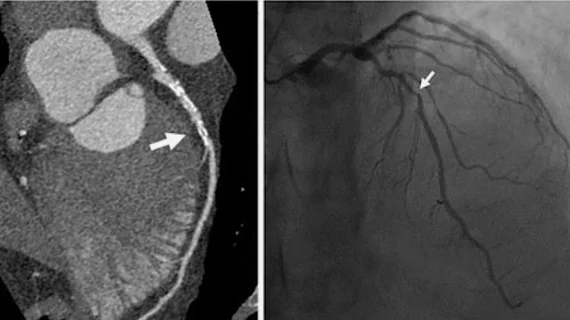CT a low-risk imaging alternative to invasive coronary angiography for suspected CAD
Cardiac computed tomography (CT) exams are an effective, low-risk alternative to cath lab based invasive coronary angiography (ICA) when treating patients with suspected coronary artery disease (CAD), according to new research published in the New England Journal of Medicine.[1]
“ICA is the reference standard for the diagnosis of obstructive CAD and enables coronary revascularization during the same procedure,” wrote lead author Marc Dewey, MD, a radiologist with Charité–Universitätsmedizin Berlin in Germany who specializes in cardiovascular and cardiothoracic imaging, and colleagues. “However, elective ICA is associated with rare but major procedure-related complications, and has been reported to reveal obstructive CAD in only 38% to 50% of the patients who are referred for the procedure in the United States and Europe.”
Cardiac CT, the authors added, has “generated interest” as a noninvasive alternative to ICA.
The group, which included specialists from 16 different countries in Europe, examined data from more than 3,500 patients who were referred for ICA due to stable chest pain and suspected CAD. Patients were randomly selected to undergo CT or ICA. CT scans were all completed on at least a 64-slice scanner and interpreted by a board-certified radiologist. ICA was completed by board-certified cardiologists.
All patients were at least 30 years old. While 56.2% of patients were women, the mean patient age was 60.1 years old. If a patient’s evaluation did not show any signs of obstructive CAD, they were discharged back to their referring physician.
Overall, after a median follow-up period of 3.5 years, the major adverse cardiovascular event (MACE) rate was 2.1% for the CT group and 3% for the ICA group. The annual MACE rate was 0.61% for the CT group and 0.86% for the ICA group.
Major procedure-related complications, meanwhile, were seen in 0.5% of CT patients and 1.9% of ICA patients. The risk was much higher for ICA patients if they underwent revascularization (4.2%) than if they did not (0.9%). Also, the group noted, coronary revascularization procedures were less common for patients in the CT group than those in the ICA group.
“Overall, we found that a strategy of initial CT resulted in no significant difference in the incidence of major adverse cardiovascular events as compared with ICA but was associated with a lower risk of major procedure-related complications and revascularization procedures,” the authors wrote.
Related Cardiac Imaging Content:
FDA Roundup: AAA EVAR recommendations, key approvals in stroke care and interventional cardiology
Q&A: William Zoghbi breaks down the future of echocardiography
Cardiac MRI a powerful tool for predicting sudden cardiac death, arrhythmia after CIED implantation
Cardiologists performing fewer in-office imaging exams
Reference:

